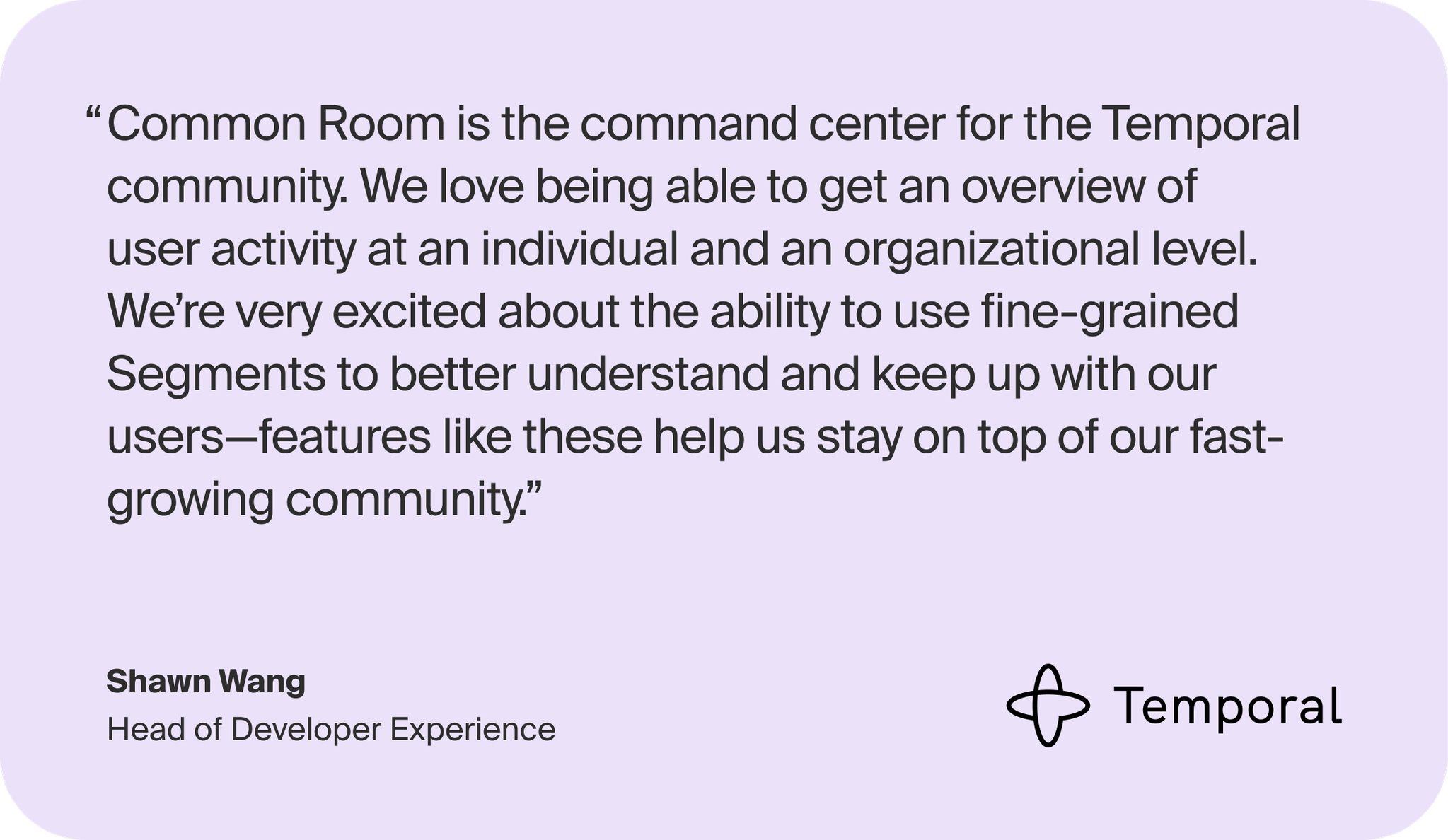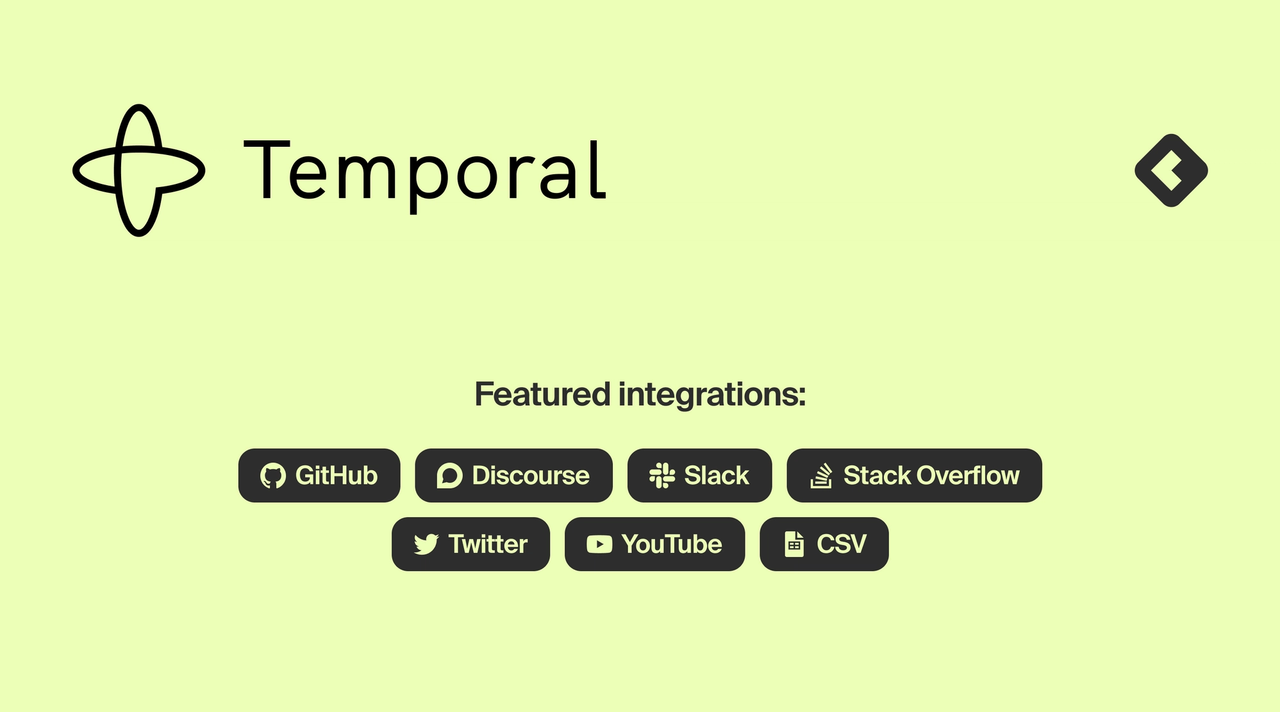Temporal empowers developers to create highly reliable and scalable applications without needing to code around everything that could go wrong in today’s complex cloud environments. It enables developers to spend their time building new features, rather than ensuring the reliability of their code. The Temporal platform is open source, and by giving developers a first-class experience, the community around Temporal has flourished. Today, Temporal has a robust community of tens of thousands of developers from leading tech companies like Snap, Netflix, Descript, Datadog, and Instacart.
The Challenge
Even from the beginning, Temporal started with a lot of community engagement across Slack and GitHub because of its open source heritage. Temporal’s Head of Product, Ryland Goldstein, joined as employee number five and one of his first priorities was bringing structure to better serve Temporal’s community. “The only reason Temporal exists is because of our amazing community,” said Goldstein. “All of our future success as a company is going to be dependent on the adoption of our open source technology and the strength of the community around it.”
Goldstein introduced stronger outbound community engagement through better release notes as well as evangelism activities like a blog and transparency report, but it was still a manual and incomplete process to understand who was in the community and what problems they were trying to solve. In a one month span, Goldstein individually messaged 600 people on Slack to learn how they were using Temporal, the challenges they were encountering, and feedback for making the product better. This effort resulted in a lot of great conversations and lasting relationships, but it wasn’t a scalable or comprehensive way to get a pulse on the community.
Temporal had tried to use the project management tool Notion to track community engagement, even setting it up as a basic customer relationship management (CRM) system. But as the sales team came onboard to help customers who wanted to move from Temporal’s open source platform to its managed service, Temporal Cloud, it became clear that the team needed a new solution to both monitor the health of its community and identify those organizations interested in Temporal Cloud.
The Solution
Temporal first heard about Common Room at a DevRel meetup. Goldstein was initially skeptical given his experience using and reviewing other community tools. Temporal was using a different community tool at the time and found it to be focused more on how to describe community health rather than bringing insights to the data it was collecting. It didn’t give the team the ability to interact with their data in the ways they wanted to or make it actionable. Common Room was different. “When I saw Common Room in action, I was immediately excited. It gives us an entire dimension of value that we just didn’t have access to before,” said Goldstein.
With Common Room, team at Temporal has been able to:
- Measure. Track community health and report on key trends in activity and engagement.
- Nurture. Get a complete view of each community member to deliver better, more tailored experiences.
- Discover. Find and grow relationships with top organizations who may be interested in Temporal Cloud.

Track community health and key trends in activity and engagement
Common Room has become the command center for Temporal’s Developer Empowerment team. It’s where they go to get an understanding of the overall health of the community and quickly see trends in community activity. Even before Common Room, the team had a strong pulse on the community through their daily conversations and engagement, but it wasn’t validated at scale. Common Room gives Temporal the big picture view—a single place where they can see across all their community channels and bring data to their anecdotal interactions. “Common Room immediately gave us those points of proof—we knew how many members were in our community, what organizations were using Temporal, and how they were engaging,” said Goldstein.
The team uses various reports in Common Room to track engagement across their community. For example, they use response rate to ensure member questions are being answered in a timely manner. Common Room can quickly surface messages that haven’t been responded to and also show if answers are coming from the team or the community itself, an important indicator of a self-sustaining community. The team can also see community engagement over time, to identify upticks or slowdowns in activity. These reports give the Developer Experience team concrete data to prove that their activities are benefiting and strengthening the community.

Deepen understanding of members to deliver better experiences
Common Room helps the Temporal team connect the dots between the different ways a member is engaging with the community as well as how different members from a single organization are interacting with the product. By automatically merging user profiles that exist across different channels and tying them to the companies they work for, Common Room gives Temporal a more complete picture of each of their community members. This more comprehensive view helps them provide a better experience with Temporal. “By seeing all the questions a member is asking in Slack together with their Discourse forum posts, we’re able to provide answers with more context and even proactively identify where certain community members could use assistance to avoid them abandoning the product,” said Goldstein.
By including a member’s company in their profile, the team is able to take this valuable context into account when engaging with community members as different sized organizations have different needs. For example, larger companies will inevitably have bigger, more complex, and challenging architectures, and visibility into this additional context helps the Temporal team provide better support.
Organizational insights drive improved customer value and sales outcomes
Because Common Room links community members to their companies, the team can also easily see which are new to Temporal or have significant adoption across their organization. The Temporal sales and customer support teams love Common Room’s Organizations view, which automatically identifies both new and the fastest-growing organizations within their community. These reports help the team ensure they know about the right community members to reach out to at the right time. Common Room helps the Temporal team find these organizations quickly, rather than having to crawl through member posts in each individual community channel and look up company information separately. “Not only does Common Room help us save time by getting to the most important conversations faster, it has become core to how we prioritize which organizations we spend our time with,” said Tim Hughes, Sales at Temporal.

Temporal also sets alerts in Common Room to automatically notify the team via Slack when someone joins their community from a new organization, or when a member from a key community takes a specific action, like posting in Discourse. These proactive notifications allow the sales and customer support teams to stay on top of the needs of the organizations they are supporting to ensure they have a great experience with Temporal. If the sales team sees that an organization is at one of these critical inflection points, they can use Common Room to get a better understanding of what areas the members of that company are most interested in or where they need support. Then sales will reach out to the product or Developer Empowerment team to set up a seminar or workshop to help the organization better understand that value they can get out of Temporal or solve the specific issue they’re working through. Lastly, Common Room allows the Temporal team to easily see and bring together community members who are from different parts of the same organization. The company appreciates and benefits from having a better understanding of how Temporal is being used across the organization. It also allows the sales team to have a more complete conversation about the value delivered by the platform.
Due to their complex environments and a desire to focus on their own applications rather than the operation and maintenance of Temporal, these larger organizations are often interested in Temporal Cloud, the managed services offering of the platform. The sales team having visibility into community conversations and adoption trigger points becomes a win-win for these members and Temporal. “First and foremost, our goal is to add value to the Temporal community,” said Hughes. “Through the timely and relevant conversation that Common Room enables us to have, we can build deeper relationships, add immediate value, and explore what solution is the best fit for their organization.”

What’s next?
Temporal has an amazing community of exceptional engineers who are leading the way in solving some of the toughest problems around cloud and distributed systems. Looking forward, the team wants to expand the Temporal community to improve the life of any developer. Common Room is going to be critical in both collecting the community feedback to make this happen as well as surfacing key community metrics to track Temporal’s progress towards this goal. “Common Room is going to be a key part of our strategy,” said Goldstein. “It will provide the command center we use to make sure we’re achieving our mission while continuing to deliver value to our existing community.”
